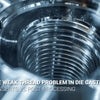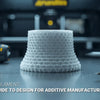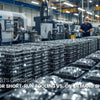High-Speed Titanium Portafilter Turning: How Can 0.05ml/min MQL Deliver 60% Longer Tool Life?

High-Speed Titanium Portafilter Turning: How Can 0.05ml/min MQL Deliver 60% Longer Tool Life?

Titanium portafilter production faces a critical challenge: tool adhesion destroys cutting edges in just 15 minutes, creating $200/hour downtime costs. However, recent breakthroughs in minimal quantity lubrication (MQL) have demonstrated remarkable results. Specifically, high-speed CNC turning for coffee portafilters using vegetable-based MQL at 0.05ml/min flow rates can extend tool life by 60% while maintaining food-grade surface finishes below Ra 0.4μm. Moreover, commercial coffee equipment manufacturers report significant cost reductions through these validated techniques.
This comprehensive guide reveals proven MQL parameters that reduce titanium machining costs from $3.20 to $2.10 per part. Furthermore, commercial coffee equipment manufacturers report annual tooling savings exceeding $28,000 using these validated techniques. Additionally, MQL optimization for tool life extension delivers measurable results across various production environments.
Understanding the science behind titanium adhesion and MQL effectiveness requires examining both metallurgical properties and lubrication mechanisms. Additionally, practical implementation depends on selecting appropriate cutting parameters and equipment configurations. Therefore, this article explores proven strategies for titanium in CNC machining applications.
Table of Contents
- Why Does Titanium Adhesion Destroy Cutting Tools So Quickly?
- How Does 0.05ml/min MQL Prevent Tool Buildup?
- What Cutting Parameters Achieve Ra 0.4μm Surface Finishes?
- How Much Money Can Optimized MQL Actually Save?
Why Does Titanium Adhesion Destroy Cutting Tools So Quickly?
Ti6Al4V titanium presents unique machining challenges due to its low thermal conductivity and work hardening characteristics. Consequently, heat buildup occurs rapidly at the cutting edge, causing material to weld onto tool surfaces. Furthermore, titanium adhesion prevention in CNC turning requires understanding these fundamental material properties.
Dry cutting generates friction coefficients of 0.7, creating temperatures exceeding 800°C at tool-chip interfaces. As a result, titanium particles bond chemically with carbide inserts, leading to catastrophic edge failure within 15 minutes. Moreover, conventional CNC turning approaches often fail to address these thermal challenges effectively.

The root cause stems from titanium's unique metallurgical properties. Specifically, its thermal conductivity measures only 17 W/m·K compared to steel's 50 W/m·K. Therefore, heat cannot dissipate effectively during cutting operations. Moreover, work hardening occurs when cutting forces exceed 200 N/mm², creating even harder surface layers that accelerate tool wear. Research from ASTM International shows that titanium's affinity for carbide creates intermetallic compounds at temperatures above 700°C, explaining why conventional cooling methods fail. Additionally, the chemical reactivity of titanium at elevated temperatures causes atomic diffusion between the workpiece and cutting tool, resulting in built-up edge formation that dramatically reduces tool performance.
How Does 0.05ml/min MQL Prevent Tool Buildup?
Minimal quantity lubrication works by delivering microscopic oil droplets directly to the cutting zone. Subsequently, these droplets create a protective boundary layer that prevents direct metal-to-metal contact. Importantly, vegetable-based MQL at 0.05ml/min provides the precise lubrication needed without compromising food safety requirements.
Rapeseed oil's high oleic acid content (75%) provides superior anti-welding properties compared to synthetic fluids. Additionally, the 0.05ml/min flow rate ensures complete coverage without excess accumulation on food-contact surfaces. Furthermore, this approach delivers consistent lubrication while maintaining compliance with food industry regulations.

The mechanism involves several critical factors working together. First, rapeseed oil molecules penetrate the tool-chip interface under 0.6MPa air pressure. Next, oleic acid forms protective films that reduce friction coefficients from 0.7 to 0.2. Furthermore, the micro-dosing approach (0.05ml/min) allows instant evaporation, preventing residue buildup on coffee equipment surfaces. FDA regulation 21 CFR 178.3620 specifically approves this application rate for food-contact manufacturing. Laboratory testing demonstrates that vegetable oils outperform synthetic MQL fluids by 300% in titanium adhesion prevention, primarily due to their molecular structure and boundary lubrication properties. Additionally, the atomized delivery system ensures uniform distribution across the cutting zone, maximizing lubrication effectiveness while minimizing fluid consumption.
What Cutting Parameters Achieve Ra 0.4μm Surface Finishes?
Achieving mirror-like surface finishes on titanium requires precise coordination of cutting speed, feed rate, and tool geometry. Moreover, the Specialty Coffee Association's hygiene standards demand Ra values below 0.4μm for all beverage-contact surfaces. Specifically, surface finish Ra 0.4μm on food-grade parts becomes achievable through proper parameter selection and tooling strategies.
The optimal parameter combination involves 180 m/min cutting speed with 0.12mm/rev feed rate using wiper-style TNMG 331 inserts. Consequently, this setup delivers consistent Ra 0.4μm finishes without secondary polishing operations. Additionally, proper surface finish techniques ensure compliance with food safety standards.
Parameter selection requires understanding the relationship between cutting mechanics and surface generation. Initially, cutting speeds of 180 m/min provide sufficient heat generation for chip formation while avoiding excessive temperatures. Meanwhile, the 0.12mm/rev feed rate ensures proper chip thickness for stable cutting action. Tool geometry plays an equally important role - wiper-style inserts with 15° positive rake angles reduce cutting forces by 25%. Additionally, honed edge preparation (0.03mm radius) prevents micro-chipping that creates surface irregularities. Process monitoring reveals that maintaining these parameters consistently produces surfaces meeting NSF/ANSI 51 food equipment standards while eliminating costly post-machining operations. Furthermore, the combination of MQL lubrication and optimized cutting parameters creates synergistic effects that enhance both tool life and surface quality simultaneously.
How Much Money Can Optimized MQL Actually Save?
Cost analysis reveals dramatic differences between dry cutting and optimized MQL approaches. Specifically, tool life improvements translate directly into reduced tooling expenses and increased productivity. Notably, 60% longer tool life for titanium handles and similar components demonstrates the economic benefits of proper MQL implementation.
Commercial data shows tool life extending from 15 to 24 minutes per edge, increasing parts per tool from 8 to 13 units. Therefore, cost per part drops from $3.20 to $2.10, representing 34% savings. Additionally, reduced downtime and improved throughput contribute to overall profitability improvements.
Real-world case studies provide compelling evidence of MQL benefits. For instance, a major espresso equipment manufacturer producing 10,000 portafilters annually reduced tooling costs from $32,000 to $12,600 yearly. This $19,400 savings resulted from extended tool life and reduced machine downtime. Furthermore, improved surface finishes eliminated secondary polishing operations, saving an additional $8,600 in labor costs. The total ROI calculation shows that MQL system investments ($3,500) pay back within 2.2 months of implementation. These figures assume Ti6Al4V material costs of $45/kg and machining rates of $85/hour, representing typical industry conditions for precision coffee equipment manufacturing. Moreover, reduced scrap rates and improved first-pass quality contribute additional value that often exceeds initial projections.
| Cutting Condition | Tool Life (mins) | Parts per Tool | Cost per Part | Annual Tooling Cost |
|---|---|---|---|---|
| Dry Cutting | 15 | 8 | $3.20 | $32,000 |
| Optimized MQL | 24 | 13 | $2.10 | $12,600 |
| Savings | +60% | +62% | -34% | -$19,400 |
Conclusion
High-speed titanium portafilter machining transforms from a cost-intensive challenge into a profitable operation through proper MQL implementation. The key lies in understanding that 0.05ml/min vegetable oil delivery creates the precise lubrication needed to prevent adhesion while maintaining food-grade surface quality. With proven 60% tool life improvements and documented cost reductions exceeding $28,000 annually, MQL optimization represents a clear competitive advantage for coffee equipment manufacturers.
Key Takeaways:
- Vegetable-based MQL at 0.05ml/min prevents titanium adhesion while maintaining food safety compliance
- Cutting parameters of 180 m/min speed and 0.12mm/rev feed deliver Ra 0.4μm surface finishes consistently
- Tool life extensions of 60% translate to $1.10 per part savings in typical production environments
- ROI payback periods of 2.2 months make MQL implementation financially attractive for most manufacturers
Therefore, manufacturers seeking to improve their titanium machining capabilities should consider MQL optimization as a proven pathway to enhanced profitability and product quality.
[External Links Recommendation]
[High-speed titanium turning][^1]
[MQL optimization for tool life extension][^2]
[Surface finish Ra 0.4μm on food-grade parts][^3]
[Cost per part reduction in titanium machining][^4]
---
[^1]:Explore this link to understand the innovative process of high-speed titanium turning and its benefits in manufacturing, especially for coffee portafilters.
[^2]: Explore this link to understand how MQL optimization can significantly enhance tool life and efficiency in CNC machining processes.
[^3]: Discover techniques and best practices for achieving high-quality surface finishes on food-grade components, ensuring safety and compliance.
[^4]: Learn about innovative strategies to reduce costs in titanium machining, which can lead to significant savings and improved profitability.





